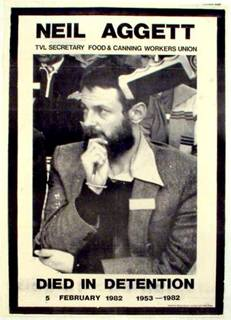This biography of Neil Aggett is taken from Steven Friedman's Building Tomorrow Today (1987)

‘In 1978, a young doctor at Soweto’s Baragwanath hospital began using his spare time to help the African Food and Canning Workers’ Union set up a Johannesburg branch. On the morning of 5 February, 1982, the doctor, Neil Aggett, now 28 years old and the secretary of A.F.C.W.U.’s Transvaal branch, was found dead in his cell at John Vorster Square police station: police said he hanged himself. He was the first white to die in detention.’
Neil was a remarkable young doctor who had come to the conclusion that ‘the diseases of his worker patients were rooted in their factory conditions’ and that unless these changed his work as a doctor would be somewhat futile.
‘Like some other young whites, he became a unionist only by rejecting the world in which he was raised. Aggett was born in Kenya to settler parents who emigrated to South Africa to escape independence. He was sent to a private school in the eastern Cape and graduated in medicine at the University of Cape Town. All this prepared him for a lucrative private medical career and an assured place in the white establishment. But university also awakened his interest in politics. He began reading political theory and turned his back on both the conservatism and the affluence of his background – he rejected luxury and moved into a labourer’s cottage without hot water or electricity.
‘… Often he would work all night at the hospital and then put in a day’s work for the union.’
Officially Neil took his own life in his cell. However, ‘we know from the record at his inquest that he endured severe interrogation and that it was after a particularly harrowing sessions that he was found hanging in his cell.’
‘His death sparked local and foreign protests unrivaled since Steve Biko, founder of the black consciousness movement, died in detention in 1977. Biko’s death sparked outrage only; Aggett’s prompted a nation wide work stoppage which reshaped the union movement and its attitude to black political organizations – and impelled it towards greater unity.
In response to his death the emerging unions organized the first national factory stoppage in South African history.
‘… On Thursday at noon, workers in scores of factories stopped work. Some held short services; at one east Cape plant white supervisors joined it. At another, SAAWU members stood motionless at their work benches for thirty minutes; the silence, said a witness, was “awesome”. At Ford, MACWUSA members stood silently too, but with clenched fists raised. At a Boksburg plant, FOSATU union members marched around the local pass office. That evening, the unions announced that 100 000 workers had taken part. The first national factory stoppage in local union history had, they said, succeeded.
‘… Aggett’s funeral, which followed two days later, also helped shape attitudes – this time to political links. Some 6000 mourners packed into St Mary’s Anglican cathedral, a cavernous stone building in central Johannesburg. In the centre sat rows of Baragwanath nurses in uniform; to either side hundreds of workers in union T-shirts. Before the service began, lilting melodies swelled from the church as mourners, in uncanny harmony, paid tribute to Aggett with union songs. After a ceremony conducted by Bishop Desmond Tutu and an oration by A.F.C.W.U. general secretary Jan Theron, they set off in procession for the burial.
‘Aggett rejected segregation in life, but the law prevented him doing so in death; he was buried in a white cemetery in suburban Johannesburg and the procession brought the emerging unions into the heart of white suburbia. Startled residents scurried to their fences as thousands of workers, marching behind union banners in the searing heat, sang their last tribute to Neil Aggett. At the graveside, A.F.C.W.U. members, speaking through an interpreter, described what the young doctor had meant to their movement and brought home the way in which he had bridged the racial gap.’



Comments